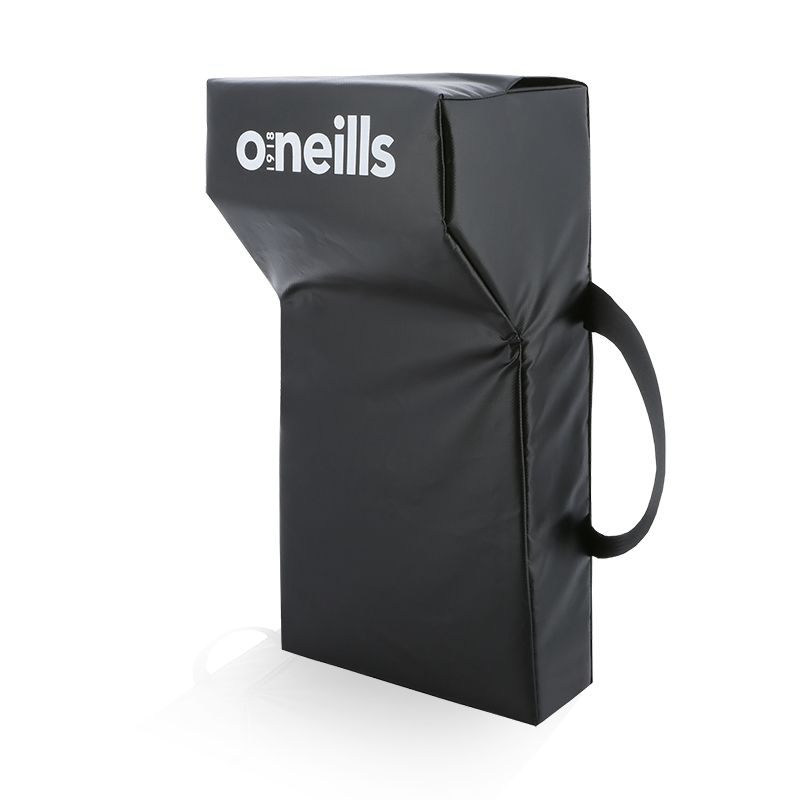A rugby tackle bag is a training tool used to practice tackling techniques safely. It helps players improve their skills without injuring teammates.
Rugby tackle bags are essential for effective training sessions. They provide a safe and controlled environment for players to hone their tackling skills. Made from durable materials, these bags withstand the intense impact of repeated tackles. Coaches use them to simulate real-game scenarios, enhancing player readiness.
The bags come in various sizes and weights, catering to different training needs. Their portability allows for easy setup and transport, making them ideal for both field and indoor training. Investing in a high-quality rugby tackle bag ensures players can practice safely and effectively, leading to better performance on the field.

Contents
Introduction To Tackle Bags
Rugby tackle bags are essential training tools. They help players practice safely. These bags simulate real-life tackling situations. Coaches use them to improve player skills and safety. Tackle bags come in various sizes and shapes. Each type serves a specific training purpose.
Importance In Training
Tackle bags are crucial for rugby training. They allow players to practice tackles without injury risk. The bags help players improve their technique. They also build strength and stamina. Consistent practice with tackle bags boosts player confidence. It prepares players for real matches.
| Benefit | Explanation |
|---|---|
| Safety | Reduces injury risk during practice |
| Technique | Improves tackling skills |
| Strength | Builds physical power |
| Stamina | Increases endurance |
| Confidence | Prepares players for real matches |
History And Evolution
Rugby tackle bags have evolved over time. Early versions were simple and less effective. They were often just padded sacks. Over the years, designs improved. Modern tackle bags use advanced materials. They provide better protection and durability.
The development of tackle bags mirrors rugby’s growth. As the game became more competitive, training tools advanced. Today, tackle bags are sophisticated. They come in different shapes, like cylindrical and wedge-shaped. Each shape targets specific training needs.
- Cylindrical bags for general tackling practice
- Wedge-shaped bags for angle tackles
- Square bags for scrummaging practice
Rugby tackle bags are now a staple in training. They have become indispensable for coaches and players. The evolution of these bags reflects the sport’s demand for safety and performance.

Types Of Tackle Bags
Tackling is a crucial part of rugby. To practice safely, players use tackle bags. These bags come in various types. Each type serves a different purpose. Let’s explore the main types of tackle bags.
Standard Tackle Bags
Standard tackle bags are the most common. They help players practice their tackling form. These bags are usually cylindrical. They come in different sizes for all age groups.
| Size | Height (cm) | Weight (kg) |
|---|---|---|
| Small | 100 | 10 |
| Medium | 120 | 15 |
| Large | 150 | 20 |
Hit Shields
Hit shields are also known as tackle shields. They are smaller and more mobile. Coaches hold these shields for players to tackle. This helps players improve their agility.
- Improves tackling accuracy
- Enhances player agility
- Useful for one-on-one training
Contact Suits
Contact suits are worn by players during practice. They allow for full-contact training. These suits protect players from injuries. They simulate real-game situations effectively.
- Provides full-body protection
- Allows for realistic training
- Reduces injury risk
Choosing The Right Tackle Bag
Choosing the right rugby tackle bag is essential for effective training. The right tackle bag helps improve your tackling skills and ensures safety. Let’s dive into some key factors to consider.
Size And Weight Considerations
Size and weight are crucial when selecting a tackle bag. A bag too large might be hard to handle. Small bags might not offer enough resistance. Here’s a simple table to guide you:
| Age Group | Recommended Size | Weight |
|---|---|---|
| Under 10 | Small | Lightweight |
| 10-15 | Medium | Moderate |
| 16 and above | Large | Heavy |
Pick the size that matches your age and strength. This ensures better training and safety.
Material And Durability
Material and durability are important for a long-lasting tackle bag. Common materials include:
- Vinyl: Water-resistant and easy to clean.
- Canvas: Durable but heavier.
- Foam Padding: Essential for absorbing impact.
Choose a tackle bag with strong stitching. This prevents the bag from tearing. Quality materials ensure the bag lasts through many training sessions.
Invest in a durable bag for long-term use and safety.
Benefits Of Using Tackle Bags
Tackle bags are an essential part of rugby training. They help players improve their technique and ensure safety. Using tackle bags can transform your training sessions.
Improved Technique
Using tackle bags helps players enhance their tackling skills. They can practice different angles and approaches. This helps players tackle with precision during games. Tackling bags also allow for repetitive practice. This leads to muscle memory and better performance.
Players can work on their footwork, body position, and grip. This makes their tackles more effective and less risky. The bag’s resistance mimics real-game scenarios. This adds authenticity to training sessions.
Enhanced Safety
Tackling can lead to injuries if not done correctly. Tackle bags help reduce this risk. They provide a safe environment to practice high-impact moves. This minimizes the chances of getting hurt during actual games.
Using tackle bags also improves players’ confidence. They can focus on their technique without fear of injury. This boosts their overall performance and morale.
| Benefits | Description |
|---|---|
| Improved Technique | Enhances tackling skills, footwork, and body position. |
| Enhanced Safety | Reduces injury risk and boosts confidence. |
Training Drills With Tackle Bags
Rugby tackle bags are essential for training sessions. They help players improve tackling skills safely. These drills can be performed both individually and in teams. Here, we explore some effective training drills with tackle bags.
Solo Drills
Practicing alone can be very beneficial. Here are some solo drills:
- Basic Tackle: Place the tackle bag upright. Run towards it and tackle it with your shoulder. This drill helps improve accuracy and power.
- Wrap and Roll: Tackle the bag. After the tackle, wrap your arms around it and roll it to the ground. This drill enhances grip strength and control.
- Explosive Hits: Start from a standing position. Sprint towards the tackle bag and hit it as hard as possible. This drill builds speed and impact force.
- Directional Tackle: Set the bag at different angles. Tackle from various directions. This drill improves versatility and reaction time.
Team Drills
Team drills build coordination and teamwork. Here are some effective team drills:
- Relay Tackles: Form two lines of players. Each player tackles the bag, then runs to the back of the line. This drill increases endurance and teamwork.
- Double Tackles: Two players tackle the bag simultaneously. This drill ensures players work together and tackle efficiently.
- Rotating Tackles: Players form a circle around the bag. Each player takes turns tackling the bag. This drill keeps everyone engaged and active.
- Obstacle Course: Set up an obstacle course with the tackle bag. Players navigate through and tackle the bag at the end. This drill is fun and improves agility.
| Drill Name | Solo or Team | Key Benefits |
|---|---|---|
| Basic Tackle | Solo | Accuracy, Power |
| Wrap and Roll | Solo | Grip Strength, Control |
| Relay Tackles | Team | Endurance, Teamwork |
| Double Tackles | Team | Coordination, Efficiency |
Maintenance And Care
Proper maintenance and care of your Rugby Tackle Bag ensure it lasts longer. Follow these simple tips to keep it in top condition.
Cleaning Tips
Keeping your tackle bag clean is crucial. Dirt and grime can wear out the material.
- Wipe down the bag after each use with a damp cloth.
- Use a mild soap solution for tougher stains. Avoid harsh chemicals.
- Rinse thoroughly and let it air dry. Do not use a dryer.
Storage Guidelines
Proper storage prevents damage to your tackle bag. Follow these guidelines for optimal storage.
- Store in a dry place. Moisture can cause mold and mildew.
- Keep away from direct sunlight. UV rays can degrade the material.
- Avoid stacking heavy objects on the bag. This can deform its shape.
Here’s a quick summary in a table format:
| Task | Recommendation |
|---|---|
| Cleaning | Wipe with damp cloth, mild soap, air dry |
| Storage | Dry place, no direct sunlight, no heavy objects |
Popular Brands And Models
Rugby tackle bags are essential training tools for rugby players. They help players improve their tackling technique and strength. Choosing the right brand and model can make a significant difference in training efficiency.
Top Manufacturers
Several top manufacturers produce high-quality rugby tackle bags. Here are some of the most popular brands:
- Gilbert Rugby: Known for durable and reliable tackle bags.
- Rhino Rugby: Offers a wide range of training equipment.
- Ram Rugby: Specializes in innovative rugby training tools.
- Canterbury: Combines durability with advanced design.
Best-selling Models
Here are some of the best-selling rugby tackle bags from these top manufacturers:
| Brand | Model | Features |
|---|---|---|
| Gilbert Rugby | G-TR4000 | High-density foam, durable outer cover, easy to clean |
| Rhino Rugby | Senior Hit Shield | Ergonomic design, reinforced stitching, weather-resistant |
| Ram Rugby | Pro Tackle Bag | Lightweight, flexible core, impact-absorbing foam |
| Canterbury | Training Tackle Bag | Multi-layered foam, durable vinyl cover, easy to carry |

Testimonials And Reviews
Rugby tackle bags are essential training tools. They help players improve their tackling skills. This section explores feedback from players and experts. Discover why these bags are a favorite among rugby enthusiasts.
Player Experiences
Many players share their experiences with rugby tackle bags. Here are some of their thoughts:
- John, a high school player: “The tackle bag helps me practice safely. My technique has improved a lot.”
- Sarah, a college rugby captain: “We use the tackle bag in every training session. It’s durable and reliable.”
- Mike, an amateur league player: “Training with the tackle bag is fun. I feel more confident in matches.”
Expert Opinions
Coaches and trainers also have positive feedback. Let’s hear what they say:
| Expert | Opinion |
|---|---|
| Coach Williams | “The rugby tackle bag is a must-have. It enhances player safety.” |
| Trainer Lucy | “This bag provides excellent resistance. Players build strength effectively.” |
| Analyst Tom | “Using the tackle bag reduces injury risks. It’s a smart investment.” |
Frequently Asked Questions
What Is A Rugby Tackle Bag?
A rugby tackle bag is a training tool used to practice tackling skills safely.
How To Choose The Right Tackle Bag?
Consider size, weight, and durability to match your training needs.
Can Tackle Bags Prevent Injuries?
Yes, they provide a safe and controlled environment to practice tackles, reducing injury risk.
Conclusion
Investing in a rugby tackle bag is essential for improving tackling skills. It ensures safety and provides effective training. Whether for professional players or beginners, a tackle bag enhances performance. Choose the right bag to elevate your game and enjoy better practice sessions.
Remember, consistent training leads to success on the field.
